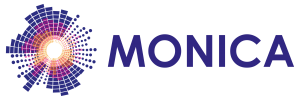MONICA EU Project

This work is supported by the European Commission through the MONICA H2020 PROJECT under grant agreement No 732350.
Tutorials
IoT-DB Tutorial simple querying
This is a tutorial for how to make simple queries in the IoT-DB and is based on using the Demonstration of staff management with LoRa based locators simulated demonstration.
- Prerequistes
- Introduction
- The OGC Sensorthings API model
- Simple browsing of the IoT-DB
- Querying using filters and expand
Prerequistes
Demonstration of staff management with LoRa based locators needs to be launched in docker, follow the instructions there.
Introduction
The IoT-DB is where all the collected data from the different sensors and fusion services are stored. The IoT-DB is a OGC SensorThings API compliant database that that supports different queries.
The OGC Sensorthings API model
The OGC Sensorthings API model has a quite simple storage model:

The most important entities in the IoT-DB are:
- Sensor: represents the different input devices, such as trackers
- Datastream: represents the streams of data, for instance positions et c. (One sensor can have many datastreams)
- Observation: The actual values/results.
The IoT-DB is based on the Open Source database GOST. The complete OGC Sensorthings API standard is available at the OGC Sensorthings API site.
Simple browsing of the IoT-DB
The best way of browsing the IoT-DB is to use the Firefox browser since it makes it possible to navigate using the links in the result. Otherwise you need to copy the links manually in the browser.
List all sensors
Use the following URL in your browser to list all defined sensors in the IoT-DB:
http://localhost:8090/v1.0/Sensors
The result will display all the avialable sensors. In this case only one, “GPS”.
List all associated Datastreams
In the previous result there is a link “Datastreams@iot.navigationLink” with the value
http://localhost:8090/v1.0/Sensors(1)/Datastreams
Following this link will display all the datastreams associated with this Sensor
Listing Observations
In the previous result there is a link named Observations@iot.navigationLink"
http://localhost:8090/v1.0/Datastreams(22)/Observations
Following this link will display all the Observations associated with this Datastream
Each observation consists of this structure:
{
"@iot.id": 34060,
"@iot.selfLink": "http://localhost:8090/v1.0/Observations(34060)",
"phenomenonTime": "2020-03-06T12:15:45.195Z",
"result": {
"type": "uwb",
"tagId": "XE",
"timestamp": "2020-03-06T12:15:45.1956577+00:00",
"last_known_gps": "2020-03-06T12:15:45.1956634Z",
"last_known_lat": 50.74455010534961,
"last_known_lon": 7.153483710857724
},
"Datastream@iot.navigationLink": "http://localhost:8090/v1.0/Observations(34060)/Datastream",
"FeatureOfInterest@iot.navigationLink": "http://localhost:8090/v1.0/Observations(34060)/FeatureOfInterest",
"resultTime": "2020-03-06T12:15:45.206336+00:00"
}
The important attributes in the Observation are:
- phenomenonTime: when the result was sampled
- resultTime: when the result was stored
- result: the observation itself. It can be a simple value or a JSON structure itself.
Querying using filters and expand
The OGC Sensorthings allow for querying by using filters and also to include related entities by using expand.
$filter
$filter is used for filtering and querying the IoT-DB. For example, to list all the Datastreams which are GPS coordinates we can filter on the Datastream description:
http://localhost:8090/v1.0/Datastreams?$filter=substringof(‘GPS/Localization-GPS’,name)
This will retrieve all the Datastreams that have GPS/Localization-GPS in their name.
$expand
A common case is that you select the Datastreams that you are interested in but you also want to include the latest Observation. This can be achieved by using $expand:
http://localhost:8090/v1.0/Datastreams?$filter=substringof(‘GPS/Localization-GPS’,name)&$expand=Observations($top=1)
For each of the Datastreams the latest Observation will be included:
{
"@iot.id": 21,
"@iot.selfLink": "http://localhost:8090/v1.0/Datastreams(21)",
"name": "GPS-TRACKER-GW-REST/GPS/Localization-GPS/XE",
"description": "uwb",
"unitOfMeasurement": {
"definition": "http://www.qudt.org/qudt/owl/1.0.0/unit/Instances.html#DegreeAngle",
"name": "position",
"symbol": [
""
]
},
"observationType": "http://www.opengis.net/def/observationType/OGC-OM/2.0/OM_Measurement",
"observedArea": {
"coordinates": [
0,
0
],
"type": "Point"
},
"Thing@iot.navigationLink": "http://localhost:8090/v1.0/Datastreams(21)/Thing",
"Sensor@iot.navigationLink": "http://localhost:8090/v1.0/Datastreams(21)/Sensor",
"ObservedProperty@iot.navigationLink": "http://localhost:8090/v1.0/Datastreams(21)/ObservedProperty",
"Observations": [
{
"@iot.id": 38031,
"@iot.selfLink": "http://localhost:8090/v1.0/Observations(38031)",
"phenomenonTime": "2020-03-06T12:44:37.417Z",
"result": {
"lat": 50.74435864835979,
"lon": 7.15352407459757,
"snr": 9.75,
"hdop": 2.90000009536743,
"host": "loranode1",
"type": "uwb",
"tagId": "XE",
"height": 141.399993896484,
"timestamp": "2020-03-06T12:44:37.4171046Z",
"battery_level": 4.07999992370605
},
"Datastream@iot.navigationLink": "http://localhost:8090/v1.0/Observations(38031)/Datastream",
"FeatureOfInterest@iot.navigationLink": "http://localhost:8090/v1.0/Observations(38031)/FeatureOfInterest",
"resultTime": "2020-03-06T12:44:37.419518+00:00"
}
]
}
By changing $top one can determine how many of the last Observations are returned.


